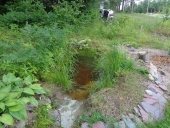
 1
1









For all your Montana Masonry Heater parts (also known as) Rocket Mass heater parts.
Visit me at
dragontechrmh.com Once you go brick you will never go back!




thomas rubino wrote:Hi Opeyemi; Welcome to Permies!
I think we will need some photo's to better understand your system.
Is this hot water for your home ? How big is the reservoir? How long is the sun shining on your collector's?
If you just had this installed ,can you ask the installer why its not working properly?
Is this a widely used system in your area? Or is this a new company?
Maybe there are others with a similar system, that have had the same problem?








For all your Montana Masonry Heater parts (also known as) Rocket Mass heater parts.
Visit me at
dragontechrmh.com Once you go brick you will never go back!
 5
5




out in the garden









For all your Montana Masonry Heater parts (also known as) Rocket Mass heater parts.
Visit me at
dragontechrmh.com Once you go brick you will never go back!
 1
1




out in the garden





thomas rubino wrote:Hi Opeyemi; First let me tell you that I have never built or lived with solar hot water. That said, so you know I am not an expert.
The only system I had first hand experience with, was for heating an outdoor swimming pool in Canada. The collector's were definitely higher than the pool.
I believe your collector's should be higher than your reservoir, to get a thermos syphon going.




Debi Baker wrote:Also on mine the panels are in parallel not in series, so water does not go thru one panel and then thru the other . It is plumbed so that fresh water goes into the bottom of both panels and hot water out of the top of both panels, so the inlet of both are connected together and the outlets of both are connected together ( not outlet of one connected to inlet of the other) That at least is how mine and others I have seen are done
Maybe you could try having the panels on one of the slops of that roof, maybe the morning sun slope, instead of balanced on the ridge and plumb the bottom of the tank to the bottom of the panels and plumb the top of the panels to the top of the tank. So the waster thermosiphons thru the panels and tank. Around here what I see is the the cold tap water then connected also to the bottom of the tank








Support Ant Village Lot Efforts On Narrow Pond
Respect your superiors...if you have any. Mark Twain
 1
1




Orin Raichart wrote:Both Debi and Frank are right on. There are only two items I didn't notice in their posts:
-for convection flow to work you need atleast 18 inches or 45.72cm height difference (which you will get when you angle the collectors);
-many hot water systems using convection flow will not work if there is an air pocket trapped in the pipes/collectors connected to your tank.
Good luck!




julian Gerona wrote:
Orin Raichart wrote:Both Debi and Frank are right on. There are only two items I didn't notice in their posts:
-for convection flow to work you need atleast 18 inches or 45.72cm height difference (which you will get when you angle the collectors);
-many hot water systems using convection flow will not work if there is an air pocket trapped in the pipes/collectors connected to your tank.
Good luck!
I agree I dont see a thermosiphon here. its natural convection flow. thermosiphon works by alternately heating and cooling a vessel full of air. this advice is correct except that height difference does no determine angle of inclination. Ideally your angle should follow the sun but not less done 30 degrees.




 3
3




 1
1





|
You didn't tell me he was so big. Unlike this tiny ad:
Support permies and give beautiful gifts to gardeners: permaculture playing cards.
https://gardener-gift.com/
|




